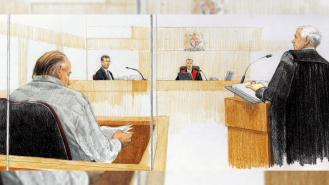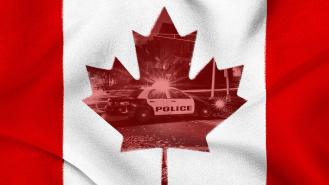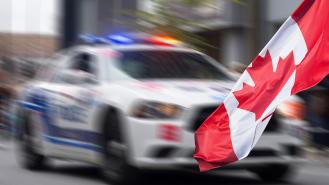
‘The sufferings of the women can only be imagined. Not one body has been found intact, and a wood chipper and Mr. Pickton's pigs are believed to have devoured much of the evidence, leaving behind mostly microscopic traces of DNA.’ New York Times 23 November 2003
Many serial killers, such as Dennis Nilsen, are only discovered after neighbours notice unusual smells. Canada’s candidate for ‘most savage psycho killer’ had a practical solution to the problem of multiple rotting bodies. Robbert Pickton fed his victims to his pigs. He is charged with the murder of just six women but is implicated in the deaths of at least 60.
Robert William ‘Willie’ Pickton was born in a suburb of Vancouver, Port Coquitlam, in British Columbia in 1949. He and his brother and sister inherited the family farm when their parents died in the 1970s. The pig farm may have been 30 miles from Vancouver but as the city expanded, Pickton started to sell off parts of his land to encroaching housing estates and shopping centres. One of the places that escaped development that Pickton liked to visit was Downtown Eastside. It was from this area that he procured prostitutes for his social club nights at the aptly named ‘Piggy’s Palace’. He found it surprisingly easy to entice women with the promise of drink, drugs and money. But perhaps surprisingly for a sex obsessed serial killer, he didn’t drink or smoke. Neighbours remember him as a quiet but hard-working man who would either work on the farm or on his salvage business. It was one of his workers, Bill Hiscox, who first fingered Pickton as a suspect. The police were aware of Pickton because he had attacked a prostitute in 1997, but the case had been dropped. Despite this, he was still blacklisted by many prostitutes who also suggested to police that Pickton might be responsible for the rise in missing women from Downtown Eastside.
Timeline
Born 26 October 1949
The Victims
Rebecca Guno (reported missing in 22 June 1983)
Sherry Rail (went missing January 1984 but not reported till 1987)
Elaine Auerbach (reported missing in mid April 1986)
Teresa Ann Williams (went missing July 1988, but not reported till March 1989)
Ingrid Soet (went missing Aug 1989, but not reported till Oct 1990)
Kathleen Wattley (went missing June 1992, but not reported till Feb 1996)
Catherine Gonzales (went missing Mar 1995, but not reported till Feb 1996)
Catherine Knight (went missing Apr 1995, but not reported till Nov 1995)
Dorothy Spence (went missing Aug 1995)
Diana Melnick (went missing Dec 1995, and reported just before the New Year)
Tanya Holyk (went missing Oct 1996, reported in Nov 1996)
Olivia Williams (went missing Dec 1996, but not reported till July 1997)
Stephanie Lane (went missing Mar 1997)
Janet Henry (reported missing Jun 1997)
Marnie Frey (went missing Aug 1997, but not reported till Sept 1998)
Helen Hallmark (went missing Aug 9997, but not reported till Sept 1998)
Jacqueline Murdock (went missing Aug 1997, but not reported till Oct 1998)
Cindy Beck (went missing Sept 1997, but not reported till Apr 1998)
Andrea Borhaven (went missing 1997, but not reported till 1999)
Kerry Koski (went missing Jan 1998, and reported missing that same month)
Jacqueline McDonnell (went missing Jan 1998, but not reported till Feb 1999)
Inga Hall (went missing Feb 1993, reported missing the next month)
Sarah Jane deVries (went missing Apr 1998, reported missing the same day)
Sheila Egan (went missing July 1998, reported the next month)
Julie Young (went missing Oct 1998, but not reported till Jun 1999)
Angela Jardine (went missing Nov1998, reported the next month)
Michelle Gurney (went missing and reported missing in Dec 1998)
Marcella Creison (went missing Dec 1998 and reported missing the next month) Ruby Hardy (went missing in 1998, but not reported till Mar 2002)
The Crimes
But how and who Pickton killed is still difficult to comprehensively establish even today because of both the method of his disposal and the judicial ban on reporting. The prosecution allege that he would lure his victims with money and drugs and cocaine traces were found in a lot of recovered tissue samples. After sex, he then strangled or shot his victims. (Bizarrely, a revolver was found with a dildo on its end, believed to have been an improvised silencer.) He would then feed their remains into his wood chipper, and serve the remains to his pigs.
As Harold Schechter points out in ‘The Serial Killers’, Pickton is not the first to use animals to dispose of evidence. Joe Ball, a 1920s bootlegger, used the bar he opened after Prohibition to lure waitresses and ex wives to his adjacent alligator pond. And as The Wineville Chicken Murders showed, (depicted in the Angelina Jolie/Clint Eastwood film, Changeling) a farm set up for the slaughter of animals, is also suitable for the slaughter of humans.
One of the few first hand witnesses to Pickton’s work was Lynn Ellingson. She lived briefly in a trailer on Pickton’s farm and said she walked in on a blood covered Pickton as a Ms Georgina Papin’s body dangled from a chain in the farm’s slaughterhouse. He disposed of Sereena Abotsway’s head, hands and feet in a bucket which he placed in a freezer where he also left bits of Andrea Joesbury’s body including her severed head. He disposed of other parts, such as the jawbones of Marnie Frey and Brenda Wolfe, and the head and hands of Mona Wilson in dustbins, manure and pig pens.When Pickton slaughtered the pigs that had been fed on slaughtered humans, he would sell on the pork.
The Investigation
Large numbers of women started disappearing off the streets of Vancouver in the 1980s. But they were mainly prostitutes, drug addicts or aboriginal women who operated in Downtown Eastside, ‘Canada’s poorest postcode.’ With no public pressure, and without any bodies to start a murder case, the police refused for years to treat the women as anything but missing, let alone connect them to becoming prey to a single predator.
But then an aboriginal group provided a list of missing women to the police and Detective Dave Dickson officially started an investigation in 1998. The first Vancouver policeman to suspect a serial killer was at work was Kim Rossmo. He would later become a criminology professor and originator of ‘geographic profiling’. He speculated that the killer was deliberately targeting women who would be ‘invisible’ to the authorities. Even when the police realised they had a serial killer, and that Pickton was a suspect, he was not placed under surveillance.
The Arrest
On 5 February 2002 police, armed with a search warrant, entered the Pickton farm looking for illegal firearms. Within hours of the 57 year old being in custody, the police obtained a second court order to search the farm as part of the ongoing 20 year police investigation into the disappearance of over 60 women from downtown. The search by dozens of forensic suited investigators amongst the slurry and dirt turned up an asthma inhaler belonging to one of the many missing, but the police could only charge Pickton with minor firearm contraventions. Later released, he was now under police surveillance.
A few weeks later, the police arrested and charged Pickton with two counts of first degree murder for the killings of Sereena Abotsway and Mona Wilson. A fortnight later, the names of Heather Bottomley, Jacqueline McDonell and Diane Rock were added to the charges. One week later, Andrea Joesbury became the sixth charge.With the addition of Heather Chinnock, Tanya Holyk, Sherry Irving and Inga Hall, the total murder charges reached fifteen, making Pickton Canada’s biggest formally charged serial killer. By this stage, large conveyor belts were being used to shift through tons of soil, going as deep as 30 feet down for sifting and DNA analysis by over 100 forensic specialists. It broke new ground for forensics. They had found blood-stained clothes and pieces of human bone and teeth. Amongst a pile of animal bones, human toes, heels and rib bones were found.
By November, there were nearly 30 charges against Pickton but investigators were constantly thwarted by the conditions on the farm and the fact that Pickton’s pigs had helped in the disposal of the evidence.
The Trial
While Pickton was waiting for the trial, a Royal Canadian Mounted Police Officer had gone undercover and pretended to be a cellmate. Pickton confessed to 49 murders. He expressed annoyance not to have rounded up to a 50 and regretted only that he become sloppy which had lead to his arrest.
During the trial, Pickton sat expressionless behind a bulletproof screen as relatives of more than 60 women looked to him for answers.
Fearing a mistrial due to contempt or prejudice, the judge had banned any reporting of the case details of Canada’s most prolific serial killer. The sheer volume of DNA evidence meant that the judge divided the trial into two. The first part would deal with just six of the charges with the remaining 20 to be heard at a later date.
After 130 witnesses and 10 months of trial, it took the jury of seven men and five women ten days to reach their verdict and on a Sunday, Pickton was convicted of second degree murder of the six women whose remains were found on his Vancouver farm. On the following Tuesday, Robert William Pickton was sentenced to life in prison with no possibility of parole for 25 years, the longest sentence possible under Canadian law. Justice James Williams said "Mr. Pickton there is really nothing that I can say to adequately express the revulsion the community feels about these killings".
As the verdict was read, two female jurors wiped away tears while Pickton finally showed some emotion. He smirked.




